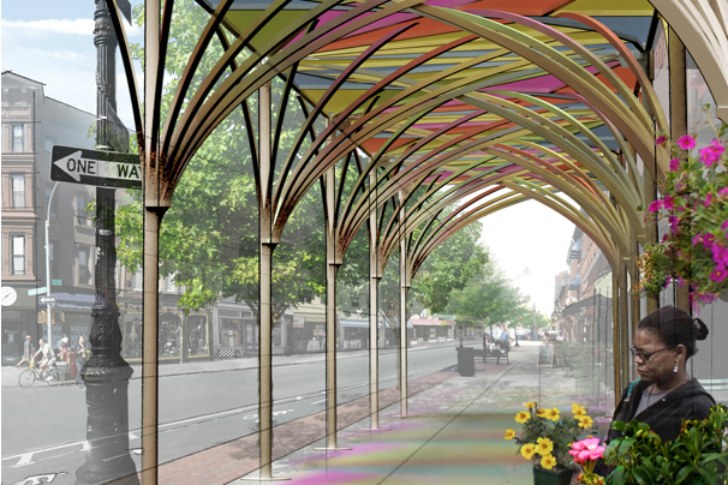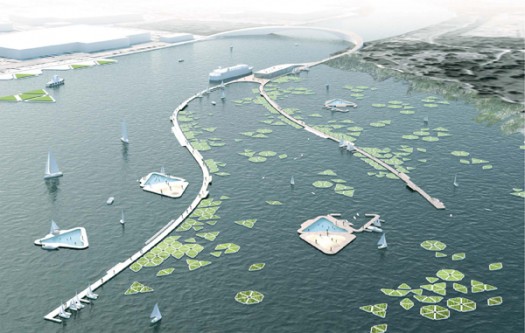
We are celebrating 15 years — and counting — of stories that are deeply researched and deeply felt, that build a historical record of what the city has been.
We are celebrating 15 years — and counting — of stories that are deeply researched and deeply felt, that build a historical record of what the city has been.

Urban Umbrella design by Young Hwan Choi, with Andrés Cortés, AIA, and Sarrah Khan, PE, of Agencie Group.
URBAN UMBRELLA
Two years ago, the NYC Department of Buildings and AIA New York sponsored a design competition to develop an innovative solution for city scaffolding. This week, the winning team unveiled the prototype of the “urban umbrella.” The UrbanSHED competition asked designers to create better “sidewalk sheds” — the ubiquitous blue plywood and metal scaffolding structures seen around town. The winning design comes from Young-Hwan Choi with architect Andrés Cortés and engineer Sarrah Khan of New York-based Agencie Group, who won $25,000 for their efforts. This prototype was constructed by Brooklyn-based architecture and fabrication firm Caliper Studio. “Urban umbrellas” feature modular metal canopies, optimized to allow natural light to reach the sidewalk and designed for cost and structural integrity, that can be custom-installed to meet site dimensions. LED lights will light up the shed at night, which will make for a far safer pedestrian overhang. See a slideshow of the prototype at Inhabitat and read more on this from The Architect’s Newspaper.
CAMPUS HOLDINGS
Mitchell Moss, Professor of Urban Policy and Planning at the Wagner Graduate School of Public Service at New York University, wrote a compelling piece for The Architect’s Newspaper on recent development trends tied to hotspots of higher education in the city. Illustrated with this beautiful map, Moss points to the fact that the city’s colleges and universities are building up and out at a time when other development is in decline. He cites an incredible statistic: “There are twice as many people enrolled in degree programs in New York City than live in the entire city of Buffalo.” Using every planner’s tool in the box, from eminent domain, rezoning, leasing, trading air rights, public-private partnerships, strategic acquisitions, to contributing space for public purposes, campuses are expanding. The most notable expansions include an additional 6.8 million square feet to Columbia’s current 17-acre Manhattanville campus, an additional 396,000 square feet to CUNY’s 3 million square foot campus, and new buildings for SVA, the New School, and Cooper Union.

Parallel Networks, designed by Ali Fard and Ghazal Jafari of Canada for Water as 6th Borough Competition
PARALLEL NETWORKS
As a challenge to envision “Water as the Sixth Borough of NYC,” the annual 2011 Terreform ONE prize asked designers to develop a vision for New York City’s future waterway use and to connect this idea with the upcoming Clean Tech World Expo. Designs focused on New York’s waterways, recreational space, transportation and local industry. The grand prize winners, Ali Fard and Ghazal Jafari of Canada, titled their work “Parallel Networks,” and received $10,000 for their work. “Parallel Networks” features a flexible network of floating pods which function as islands for public space and habitat space, with renewable energy, water filtration and food production elements. The pods are easily moveable and adapt to their environment. The modular, add-on system can be grown to diverse scales or could start small, holding potential for adaptation to climate change and other factors. See the full winning design here, as well as other honorable mentions.
FOOD POLICY
New York City Council enacted five bills and several resolutions this week, intending to bring more locally produced food to city residents, schools and jails. The passed initiatives were largely distilled from Speaker Christine Quinn’s “FoodWorks New York,” the proposed comprehensive food system plan for New York City. According to Quinn, New York is the second largest institutional purchaser of food in the city, after the U.S. Department of Defense, which hints at the huge potential these efforts have to influence the region’s food market. Notable measures include: amending administrative code to encourage the purchasing of food grown and processed in New York State; Intro 338-A, which aims to make it easier to construct rooftop greenhouses; and Intro 615, which requires an annual report on the food system from City administration. For more on the benefits and challenges of the City Council’s legislation, take a look at this blog on food policy and this recent piece published in Gotham Gazette by Nevin Cohen, food policy expert and Professor at the New School (who also spoke with us last year about the Five Borough Farm project).
POP-UP FARM IN MIDTOWN?
GOOD Magazine reported this week that a food-producing pop-up farm has been constructed east of the FDR drive in Midtown. The farm sits in the middle of what should have been the Alexandria Center, a bioscience complex that has since been stalled by its developer. Instead of letting the space go, the developer has partnered with GrowNYC to grow fresh vegetables for Chef Tom Colicchio’s Riverpark restaurant. All the vegetables have been planted in removable milk crates for the time being, considering the site will likely be built out at some point in the future. New York City has more than 600 stalled construction sites and 596 acres of vacant public land. Could milk crate farms be the future for urban ag? See more at GOOD.is.
The Roundup keeps you up to date with topics we’ve featured and other things we think are worth knowing about.
The views expressed here are those of the authors only and do not reflect the position of The Architectural League of New York.